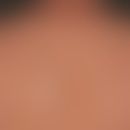HistoryThis section has been translated automatically.
Fleming, 1928
DefinitionThis section has been translated automatically.
Mould (filamentous fungus) with enzymatic activity to form penicillin. Important as inhalation allergen. It reaches its highest spore concentration in winter until spring.
You might also be interested in
General definitionThis section has been translated automatically.
- Macromorphology: the surface is woolly and velvety, water droplets are often found on the colony. The colour is white at the beginning, later yellow, green, blue, at the edge the colony remains white.
- Penicillium species produce important highly effective antibiotics but also highly toxic mycotoxins.
Occurrence/EpidemiologyThis section has been translated automatically.
Worldwide, ubiquitously distributed. Especially in the soil, on plants and food. Often found as contamination in fungal cultures (especially when grown at room temperature of 20-25 °C).
MicroscopyThis section has been translated automatically.
- Typical, round, unicellular conidia (size: 2-5 µm Ø) arranged in a brush shape (unbranched chains).
- Septed hyaline hyphae (size: 1-5 µm Ø).
- Simple or branched conidiophores.
- Very numerous primary and secondary metulae with bulb-shaped phials.
Notice! Penicillium spp. can be clearly distinguished from dermatophytes by the conidia!
LiteratureThis section has been translated automatically.
- Boscolo P (1999) Sensitisation to Aspergillus fumigatus and Penicillium notatum in laboratory workers. Int J Immunopathol Pharmacol 12: 43-48
- Diggins FW (1999) The true history of the discovery of penicillin, with refutation of the misinformation in the literature. Br J Biomed Sci 56: 83-93
- Fleming A (1929) On the antibacterial action of cultures of a penicillium, with special reference to their use in the isolation B. influenzae. Br J Exp Pathol 10: 226
Outgoing links (1)
Allergen;Disclaimer
Please ask your physician for a reliable diagnosis. This website is only meant as a reference.







